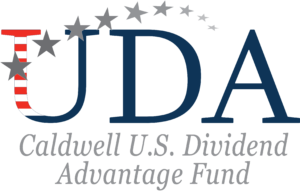The Caldwell U.S. Dividend Advantage Fund (“UDA”) gained 1.3% CAD, versus 1.8% CAD (2.8% USD) for the S&P 500 Total Return index (“Index”)1.
The Utilities sector (-6.1%) was the worst performing sector within the Index while Energy (+22.7%) saw strong gains tied to a rebound in commodity prices. Financials (+11.5%) also performed well tied to rising interest rates and a rotation into value names that underperformed in 2020.
While lack of exposure to Energy and Bank stocks created a relative drag on performance, top UDA performers in February were CDW Corp. (“CDW” +19.5%), Tetra Tech Inc. (“TTEK” +14%) and KLA Corp. (“KLAC” +11.4%)2.
CDW is one of the largest U.S. information technology re-sellers, offering more than 100,000 products and services from over 1,000 vendor partners. The company reported a strong backlog in its Education customer segment as U.S. school systems continue to equip students with hardware and software that permit remote learning. State and Local IT investments have held up well despite budget pressures highlighting the mission critical nature of these projects. Improvement in the Corporate and Small business customer segment will be largely tied to the broader economic recovery, which should be helped by the most recent $1.9 trillion stimulus package. Lastly, business re-openings and return to office means previously stalled projects and new project starts are expected to return with accelerating cadence throughout the year.
Tetra Tech is a global provider of consulting and engineering services to government and private sector clients with a focus on water and environmental projects. Management hinted that growth in the Federal government segment (approximately 1/3 of revenue) could drift toward the upper end of the historical 5-10% range under the new Biden administration and the mix could continue shifting to higher margin services. While full year guidance came ahead of expectations, an infrastructure bill could drive further upside. Travel restrictions and lockdowns have delayed some projects in the U.S. and U.K. however it seems the worst is behind the company with restarts improving throughout the year. M&A could be a further catalyst for the stock, with management noting ample balance sheet capacity and a strong pipeline of opportunities that would be accretive to earnings.
Management at KLA Corp. noted solid demand trends continuing into 2021. Specifically, orders from semiconductor foundries have remained extremely strong given elevated demand from nearly every end market that has placed constraints on existing capacity. An increase in service contract penetration on new equipment sales provides a larger base of recurring revenue which should reduce earnings volatility over time. Lastly, KLA is running ahead of their 2023 profitability targets and has identified an additional $30 million of cost synergies from the transformative Orbotech acquisition, on top of the $50 million originally set out. With a consistent stream of headlines highlighting plans for new foundry capacity, we remain encouraged about KLA’s long term growth prospects and expect improving profitability will translate into strong shareholder returns in the mid to long term.
1Standard performance as at February 28, 2021:
Caldwell U.S. Dividend Advantage Fund Series F: 1 Year: 13.7%, 3 year: 9.6%, 5 year: 10.6%, Since Inception (June 19, 2015): 8.6%.
S&P500 Total Return Index: 1 Year: 23.8%, 3 year: 13.7%, 5 year: 15.3%, Since Inception (June 19, 2015): 13.8%.
2Actual investments, first purchased: CDW 7/29/2020, TTEK 9/25/2020, KLAC 6/22/2020.
All data is as of February 28, 2021 sourced from CapitalIQ, unless otherwise indicated. Fund returns are from FundData.
UDA and Index total return numbers are in CAD terms. Sector returns and individual stocks are on a USD basis. The Fund was first offered to the public as a closed-end investment since May 28, 2015. Effective Nov. 15, 2018 the Fund was converted into an open-end mutual fund such that all units held were redesignated as Series F units. Performance prior to the conversion date would have differed had the Fund been subject to the same investment restrictions and practices of the current open-end mutual fund.
The information contained herein provides general information about the Fund at a point in time. Investors are strongly encouraged to consult with a financial advisor and review the Simplified Prospectus and Fund Facts documents carefully prior to making investment decisions about the Fund. Commissions, trailing commissions, management fees and expenses all may be associated with mutual fund investments. Rates of returns, unless otherwise indicated, are the historical annual compounded returns including changes in unit value and reinvestment of all distributions and do not take into account sales, redemption, distribution or optional charges or income taxes payable by any unitholder that would have reduced returns. Mutual funds are not guaranteed; their values change frequently and past performance may not be repeated. The payment of distributions should not be confused with a fund’s performance, rate of return or yield. If distributions paid are greater than the performance of the fund, your original investment will shrink. Distributions paid as a result of capital gains realized by a fund, and income and dividends earned by a fund, are taxable in your hands in the year they are paid. Your adjusted cost base (“ACB”) will be reduced by the amount of any returns of capital and should your ACB fall below zero, you will have to pay capital gains tax on the amount below zero.
Publication date: March 10, 2021.

